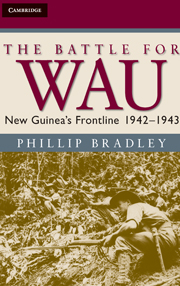Book contents
- Frontmatter
- Dedication
- Contents
- List of illustrations
- Foreword by Peter Ryan
- Acknowledgements
- Prologue
- 1 Salamaua Falls
- 2 Commandos
- 3 Scorched earth
- 4 Undermined
- 5 Convoy
- 6 Assault on Mubo
- 7 17th Brigade
- 8 ‘They came like the rain’
- 9 ‘Life blood of green’
- 10 Force of arms
- 11 Lost airmen
- 12 Retreat from Wau
- Conclusion
- Notes
- Abbreviations
- Bibliography
- Index
- Frontmatter
- Dedication
- Contents
- List of illustrations
- Foreword by Peter Ryan
- Acknowledgements
- Prologue
- 1 Salamaua Falls
- 2 Commandos
- 3 Scorched earth
- 4 Undermined
- 5 Convoy
- 6 Assault on Mubo
- 7 17th Brigade
- 8 ‘They came like the rain’
- 9 ‘Life blood of green’
- 10 Force of arms
- 11 Lost airmen
- 12 Retreat from Wau
- Conclusion
- Notes
- Abbreviations
- Bibliography
- Index
Summary
A major change in Japanese strategic thinking in the South-West Pacific at the beginning of 1943 would have an enormous impact on the Wau/Salamaua area. Following the major reverses at Guadalcanal in the Solomon Islands and on the northern Papuan coast, Lieutenant-General Hitoshi Imamura's 8th Area Army headquarters had decided to strongly reinforce the New Guinea mainland. Reinforcements would be sent from Rabaul to Wewak, where the 2nd Special Naval Base Unit, commanded by Rear-Admiral Kamata, and one battalion from the 5th Division, commanded by Lieutenant-Colonel Konishi, were to be landed. Madang was also to be reinforced from Rabaul, with two battalions from the 5th Division, commanded by Lieutenant-Colonel Hanawa, plus an airield construction unit. Using these units, Wewak and Madang were to be secured as future landing points. Two further army divisions were allocated for transfer to the New Guinea theatre from elsewhere, the 20th Division from Formosa and the 41st Division from northern China. Extra air units would be sent once suitable airields had been constructed. Considerable reinforcements would also be sent from Rabaul to Lae. Lieutenant-General Hatazo Adachi, the 18th Army commander, planned to secure the Lae and Salamaua area using the recently arrived 51st Division, which had been shipped from Korea to Rabaul in eight transports.
At the end of December 1942, USAAF reconnaissance aircraft showed that some 21 warships and 69 merchant vessels were anchored at Rabaul.
- Type
- Chapter
- Information
- The Battle for WauNew Guinea's Frontline 1942–1943, pp. 74 - 90Publisher: Cambridge University PressPrint publication year: 2008



